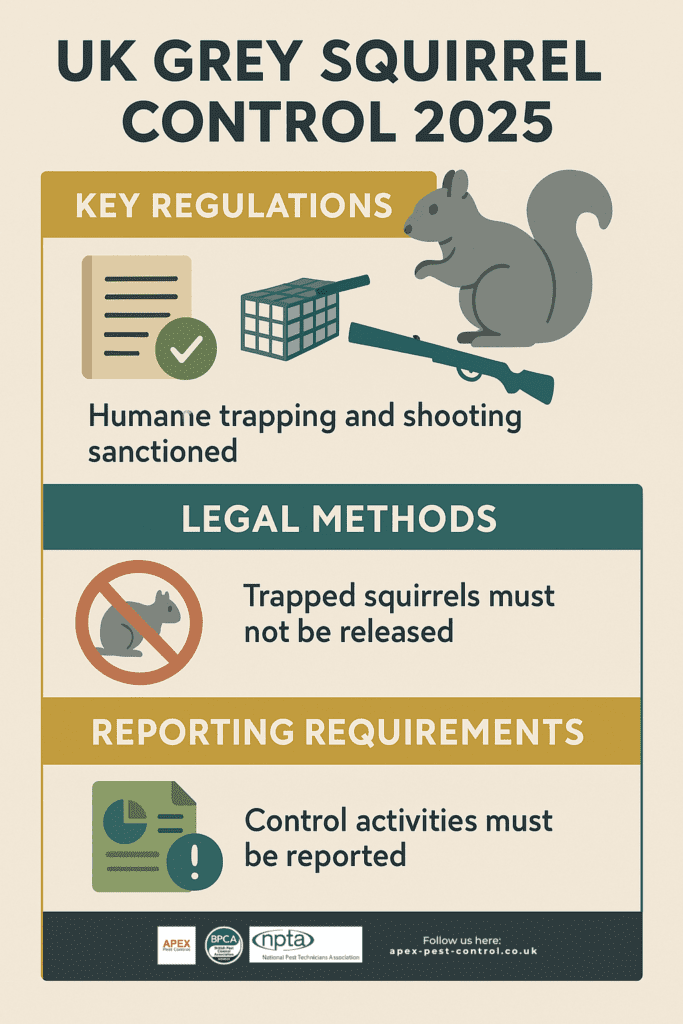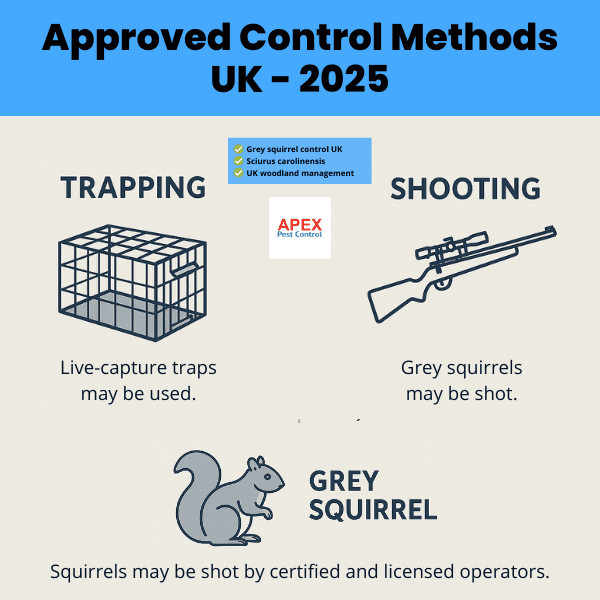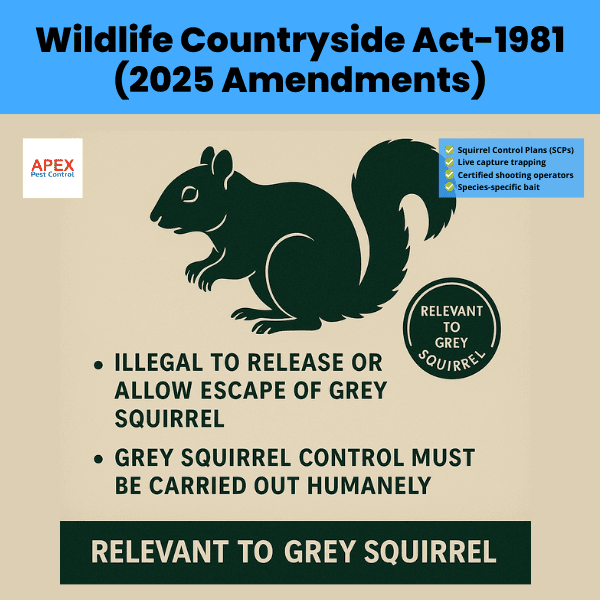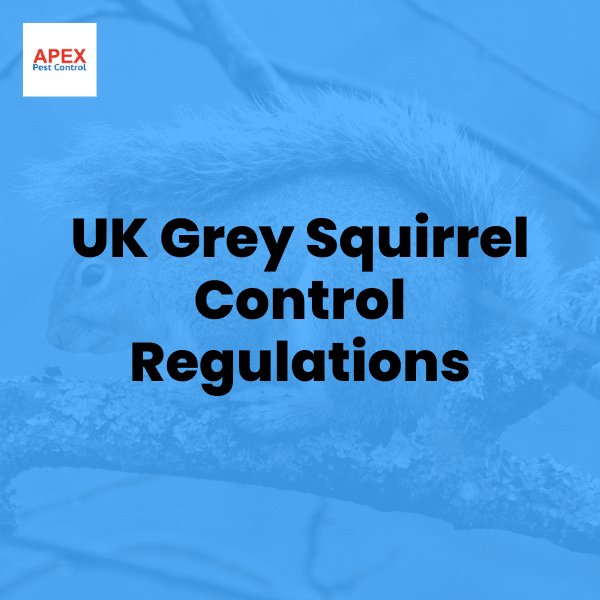UK Grey Squirrel Control: Regulations and Best Practices
Grey squirrels (Sciurus carolinensis) threaten UK woodlands and native red squirrel populations. As of March 2025, land managers, conservationists, and volunteers tackle this issue with approved, humane methods, balancing ecological preservation with strict pest control regulations.
Learn how grey squirrel control affects local ecosystems with our environmental impact guide, highlighting responsible methods and sustainable pest management practices.
Legal Framework and Control Methods

The Wildlife and Countryside Act 1981 governs grey squirrel control in the UK. Key entities and provisions include:
- Natural England: No longer issues release licences for grey squirrels.
- Forestry Commission: Mandates Squirrel Control Plans (SCPs) for specific grants.
- DEFRA: Oversees the national grey squirrel management strategy.

Shooting (by certified and licensed operators)
It has been illegal to import and keep these animals under existing British legislation dating from 1937. These actions will remain illegal under the Invasive Alien Species (Enforcement and Permitting) Order in line with the EU Regulation (1143/2014) on invasive alien (non-native) species and domestic policy.
Under the Wildlife and Countryside Act 1981 it is also currently an offence to release grey squirrels without a licence. The Invasive Alien Species (Enforcement and Permitting) Order will mean that Natural England will no longer issue release licences for grey squirrels.
Biosecurity Minister Lord Gardiner said:
Invasive non-native species, including the grey squirrel, not only challenge the survival of our rarest species but damage some of our most sensitive ecosystems, costing the economy more than £1.7 billion per year.
This order prevents the release of these animals back into the wild to help protect the endangered red squirrel, with only 15,000 left in England. There is no requirement for vets to euthanise injured or healthy squirrels as a result of this order.
- Wildlife and Countryside Act 1981 (as amended) – Northern Ireland Wildlife Order Illegal to release, or to allow to escape, to the wild any captive grey squirrel
- Wild Mammals (Protection) Act – Illegal to subject them to willful acts of cruelty or abuse
- Destructive Imported Animals Act 1932 – It is an offence to keep a grey squirrel in captivity, except under a license
Approved methods encompass:
- Live capture trapping (essential in red squirrel habitats).
- Spring traps (suitable where red squirrels are absent).
- Shooting (by certified operators).
Best Practices for Control
- Focus trapping efforts between March and September.
- Use species-specific bait, like whole maize, for effectiveness.
- Ensure humane dispatch protocols post-capture.
- Regularly assess damage and survey populations.

Landowner Responsibilities and Compliance
Landowners must:
- Secure permissions for control activities.
- Align humane dispatch with the Animal Welfare Act 2006.
- Submit cull data to the Forestry Commission’s blockchain-verified system.
- Join efforts like the UK Squirrel Accord.
Countryside Stewardship Grants and Economic Implications
Support includes:
- WS3 grants funding for 40% of trap networks.
- Woodland management grants tied to effective squirrel control.
- Carbon credits for preserved woodlands (new in 2025).

Technological Advancements in Control
Emerging tools include:
- Drone-assisted nest surveys (£120/ha).
- IoT trap networks with real-time alerts.
- AI-powered population prediction models.
Future Trends and Research
The UK Squirrel Accord drives research into:
- Oral contraceptives for population control (trials in 2026).
- Gene editing to adjust offspring ratios (projected for 2030).
Frequently Asked Questions
Can I relocate a trapped Grey Squirrel?
No, you cannot legally relocate trapped grey squirrels in the UK. The Invasive Alien Species Order 2019 makes it illegal to release grey squirrels into the wild. This law applies to all of the UK, including England, Scotland, Wales, and Northern Ireland.
The reasons for this law are:
- Grey squirrels are considered an invasive species.
- They can harm native red squirrels by competing for food and spreading diseases.
- They can damage trees and crops.
If you trap a grey squirrel, you have three options:
- Keep it in captivity for its lifetime (with proper permits).
- Have it humanely put down by a vet.
- Turn it over to a licensed wildlife rescue centre.
It’s important to note that moving grey squirrels to a new area can be harmful to them and to local ecosystems. Always follow the law and seek advice from wildlife experts if you’re unsure what to do.
Are there any non-lethal control methods available?
Yes, several non-lethal methods exist to manage wildlife:
Trapping and moving animals
- Building fences or barriers
- Using sprays or noises to scare animals away
- Changing the environment to make it less attractive
Scientists are also working on ways to control animal breeding without harming them. These include:
- Vaccines to prevent pregnancy
- Hormone treatments
- Surgery to stop animals from having babies
Some of these methods are already being used, while others are still being tested. Controlling breeding looks promising but needs more study before it can be used widely.
Non-lethal methods are often kinder and more accepted by people. However, they can sometimes cost more or work less well than lethal methods. Often, the best approach uses a mix of different methods, depending on the situation.
How do I apply for a Countryside Stewardship grant for squirrel control?
To apply for a Countryside Stewardship grant for squirrel control, follow these steps:
- Contact the Rural Payments Agency (RPA): Register on their system and ensure your details are up to date. You’ll need a Customer Registration Number (CRN) to proceed.
- Request an Application Pack: For squirrel control, you’ll likely need the Higher Tier Countryside Stewardship application. This includes forms, guidance documents, and maps.
- Develop a Squirrel Control Plan: Work with your local **Forestry Commission officer to draft a plan outlining how you’ll manage grey squirrels and protect woodland biodiversity.
- Complete the Application: Fill out all required forms, including:
- The main application form
- Annexes
- Farm Environment Record (FER) map
- Environmental Information map
- Apply for Specific Options: Include options like:
- WS3: Squirrel control supplement (£60 per hectare)
- FY3: Squirrel traps and maintenance (80% of costs)
- Submit by Deadline: Send your completed application via email or post before the annual deadline (usually late July).
For full details, visit the official GOV.UK website or contact the RPA directly.
What should I do if I spot a grey squirrel in a red squirrel conservation area?
If you spot a grey squirrel in a red squirrel conservation area, act quickly:
- Use the SquirrelAlert UK app on your smartphone.
- Contact your local wildlife trust if you don’t have the app.
- Report on websites of nearby red squirrel conservation groups.
Quick reporting helps conservationists:
- Monitor grey squirrel distribution
- Safeguard red squirrels from squirrelpox virus and competition
- Develop strategies for grey squirrel population management
Grey squirrels pose a significant threat to native red squirrels, outcompeting them for resources and spreading disease. Your prompt report can contribute valuable data to conservation efforts, aiding in the protection of Sciurus vulgaris (red squirrel) populations across the United Kingdom.
By reporting sightings, you become an essential part of citizen science initiatives supporting red squirrel conservation!
How often should I report my cull data?
The Forestry Commission requires annual reporting of cull data for effective wildlife management. For both deer and squirrels, you need to submit your cull records once a year. The reporting period typically runs from May 1st to April 30th.
Your annual report should include:
- Number of animals culled (deer or squirrels)
- Time spent on control activities
Keep detailed records throughout the year using the Forestry Commission’s templates. Submit your data to your local Forestry Commission office by email before the end of April each year.
Regular reporting helps monitor wildlife populations and protect woodland ecosystems. It’s an important part of sustainable forest management and conservation efforts.
What are pest control regulations?
Pest control regulations are rules that govern how we deal with unwanted critters in our homes, businesses, and farms. These guidelines, set by local authorities, aim to keep us safe and healthy. Key laws include the Prevention of Damage by Pests Act 1949, the Food Safety Act 1990, and the Public Health Act 1961.
These rules require:
- Regular pest checks
- Safe pest removal methods
- Keeping track of pest problems
- Proper use of pest-killing chemicals
Businesses must follow these rules or face penalties. Farmers need to control pests without harming nature. These regulations help protect our food and keep our surroundings clean and safe.
In simple terms, pest control regulations are the rulebook for keeping bugs and rodents in check while ensuring everyone’s wellbeing.
Why do we need pest control regulations?
Pest control regulations are important rules that help keep people, animals, and the environment safe. Here’s why we need them:
- Health protection: Pests like rats and mosquitoes can make people sick. Rules make sure we get rid of pests safely without hurting people.
- Protecting nature: Some pest killers can harm plants and animals. Regulations limit the use of harmful chemicals to keep our environment healthy.
- Safe food: Rules help farms and restaurants keep pests away from our food without using dangerous methods.
- Saving money: Good pest control stops big pest problems before they start, which saves money for homes and
- Fair business: Rules make sure all pest control companies follow the same safe practices.
These regulations help us manage pests effectively while keeping everyone and everything around us safe.
Who needs to comply with these regulations?
Everyone—including homeowners, business owners, and farmers—must comply with regulations relevant to their specific settings, whether residential, commercial, or agricultural.
These rules are designed to ensure safety, legal compliance, and environmental protection across all sectors.
Homeowners: Must follow local building codes, environmental laws, and health and safety standards. For example, they need to comply with water usage regulations to prevent contamination or adhere to zoning laws when making property changes.
Business Owners: Businesses are required to meet industry-specific regulations such as workplace safety standards (e.g., OSHA), financial compliance laws (e.g., anti-money laundering), and consumer protection rules enforced by agencies like the FTC.
Farmers: Agricultural operations must adhere to land-use planning permissions, environmental safeguards, and food safety standards. For instance, converting agricultural buildings for commercial use requires local authority approval.
Compliance is essential to avoid fines, legal penalties, or operational disruptions. These regulations are enforced by governing bodies at the local, state, and federal levels to maintain public welfare and sustainability.
Conclusion
Effective grey squirrel management across the UK demands a comprehensive strategy, integrating legal adherence, humane methods, and cutting-edge technologies.
By keeping abreast of regulations and optimal techniques, stakeholders can play a vital role in safeguarding UK woodlands and supporting the preservation of native red squirrel populations.

Tony Johnson, Founder & Lead Technician at Apex Pest Control, is a BPCA and NPTA accredited pest management expert with over 35 years’ hands-on experience. Tony specialises in Integrated Pest Management and ensures all services comply with UK pest legislation, including the Wildlife and Countryside Act 1981 and COSHH Regulations 2002. His commitment to continual learning and adapting to industry best practices means clients receive effective, safe solutions for pests affecting homes and businesses across South Yorkshire. Tony’s dedication to professional standards, ethical treatment methods, and local expertise has made him a trusted partner for pest control and prevention.
-
BPCA & NPTA accredited | CHAS certified
-
Committed to UK pest law compliance & safety
-
Focused on effective, ethical pest management for South Yorkshire


